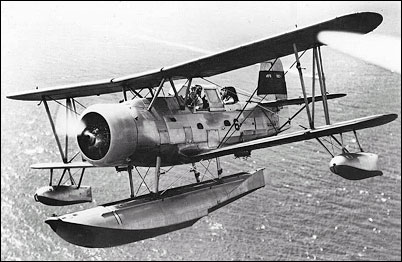 |
Curtiss Model 71 / SOC Seagull1934 |  |
| SCOUT/OBSERVATION AIRCRAFT | Virtual Aircraft Museum / USA / Curtiss |
 |
Last of the Curtiss biplanes to be used operationally by the US Navy, the SOC Seagull has a service history which very nearly duplicates that of the Royal Navy's Fairey Swordfish torpedo-bomber. Both originated in 1933, both should have become obsolescent during the early stages of World War II, both remained operational until the end of the war surviving, superbly, later designs intended to replace them. The US Navy's requirement for a new scouting/observation aircraft was circulated to US manufacturers in early 1933, resulting in proposals from Curtiss, Douglas and Vought, but it was the XO3C-1 prototype, company-designated Curtiss Model 71, ordered on 19 June 1933 and first flown in April 1934, which was ordered into production as the SOC-1 (Model 71A). This changed official designation reflected the combination of scout and observation roles. When first flown the prototype was equipped with amphibious landing gear, twin main wheels being incorporated in the central float. However, standard production aircraft were built as floatplanes, with non-retractable tailwheel landing gear optional; in any event they were easily convertible from one configuration to the other. Construction was mixed, with the foldable wings and tail unit of light alloy, a welded steel-tube fuselage structure, and a mixture of light alloy and fabric covering. The pilot and gunner/observer were accommodated in tandem cockpits, enclosed by a continuous transparent canopy with sliding sections for access. To provide a maximum field of fire for the flexibly-mounted gun in the rear cockpit, the turtleback could be retracted. Deliveries of the first SOC-1 production aircraft began on 12 November 1935. These were powered by Pratt & Whitney R-1340 Wasp engines, and the first squadrons to become fully equipped with the type comprised Scouting Squadrons VS-5B/ -6B/ -9S/ -10S/ -11S. Production of 135 SOC-1s was followed by 40 examples of the SOC-2 (Model 71B) with wheeled landing gear, detail improvements and R-1340-22 Wasp engines. A total of 83 examples of the SOC-3 (Model 71E) was built, these being generally similar to the SOC-1. SOC-2s and SOC-3s, after modification to install arrester gear during 1942, became redesignated SOC-2A and SOC-3A respectively. Curtiss also built three aircraft virtually the same as the SOC-3 for service with the US Coast Guard: these SOC-4 (Model 71F) aircraft were acquired by the US Navy in 1942 and equipped with arrester gearto bring them up to SOC-3A standard. In addition to the SOC Seagulls built by Curtiss, 44 were produced by the Naval Aircraft Factory at Philadelphia, Pennsylvania. Basically the same as the Curtiss-built SOC-3, these were designated SON-1 or, if fitted with arrester gear, SON-1A. Following termination of SOC production in early 1938, Curtiss became involved in the development and manufacture of a successor, designated SO3C Seamew. However, when the operational performance of the Seamew proved unsatisfactory it was withdrawn from first-line service; all available SOCs then reverted to operational status, continuing to fulfil their appointed role until the end of the war.

Shelley Jones, e-mail, 22.10.2023  Doug Campbell Doug CampbellDoug, thank you so much for all of this information. Not too long after I posted on here I ask a brother if he knew and it turns out his son has our dad's flight book. He looked it up and found the pilots name but the rest of the info we did not have: a destroyer picked them up; they were transferred to the USS Lexington and "Butch" shot the zeros down! Rei8d, e-mail, 02.04.2021  Annette Yates Annette YatesAnnette, Shelley Jones, e-mail, 22.10.2023  Michael Garvey Michael GarveyHi Michael, my father was a radioman flying with pilot Lt. Alfred M. Roberts in a SOC-1 off the USS New Orleans at Wake Island. They were scouting on Oct. 5, 1943 when their SOC was shot down by three Jap zeroes. They bailed and were picked up by a destroyer thankfully. Marilynn K Laird, e-mail, 18.03.2021  Geoff Woad Geoff WoadGeoff the airplane you saw was likely the Naval Aircraft Factory N3N-3 that is owned by Buffalo Joe McBryan and is at Yellow Knife NWT
|  COMPANY PROFILE | ||||||||||||||||||||||||||||||||||||||||||||||||||||||||||||
 |

|


Curtiss SOC-1 BuNo 9988 was attached to USS New Orleans (CA-32) and lost at Wake Island on 5 October 1943. Fuselage designation #88. The pilot was Lt. Alfred M. Roberts, the passenger was Radioman George W. McCarthy. The Seagull was shot down by three Japanese Zeroes. Both crewmembers were wounded when strafed by the Zeroes after they had parachuted out of the Seagull â€" Lt. Roberts was hit in the groin and Radioman McCarthy was shot through the knee. It was a formation of F6F Hellcats, led by Lt. Commander “Butch” O’Hare, swooped in and shot the Zeroes down. They were both picked up by a U.S. destroyer while taking fire from Japanese shore batteries on Wake Island. Two days later the destroyer turned over the two men to the USS Lexington (CV-16) for further hospitalization. It is known that Lt. Roberts was later transferred to USS Puget Sound (CVE-113) and from there was transferred, on 2 July 1945, to the U.S. Naval Hospital in Seattle, WA.
reply